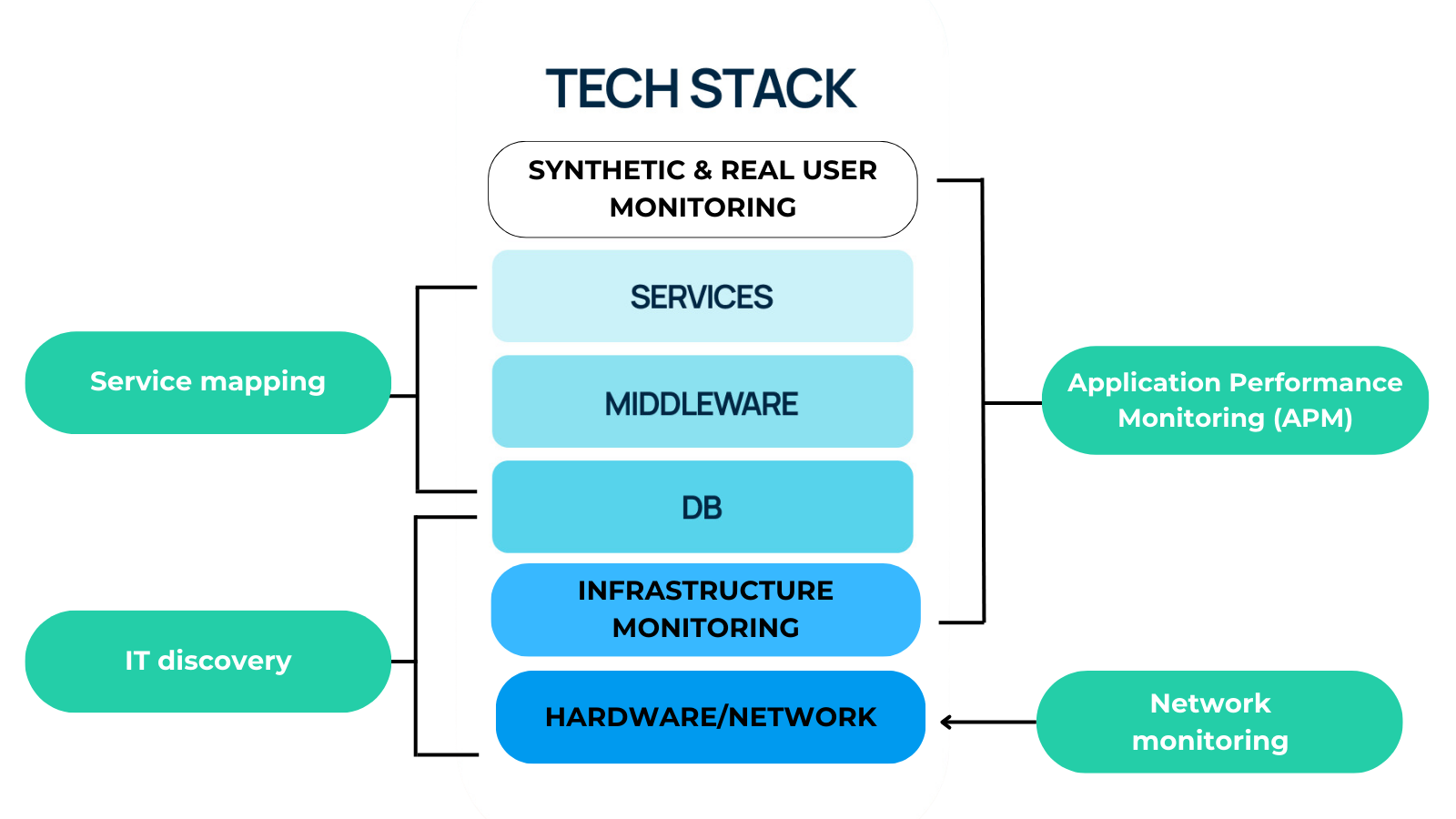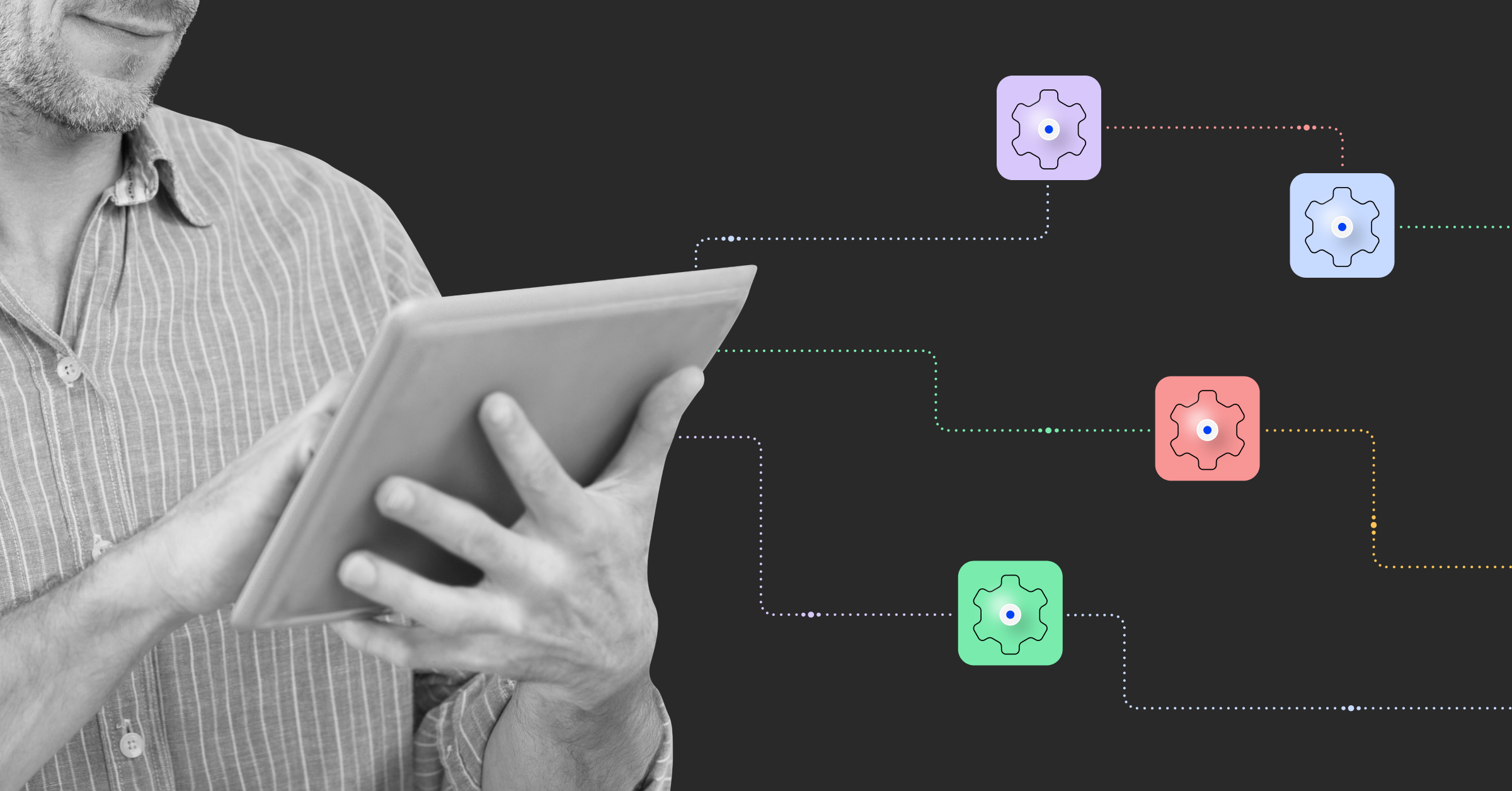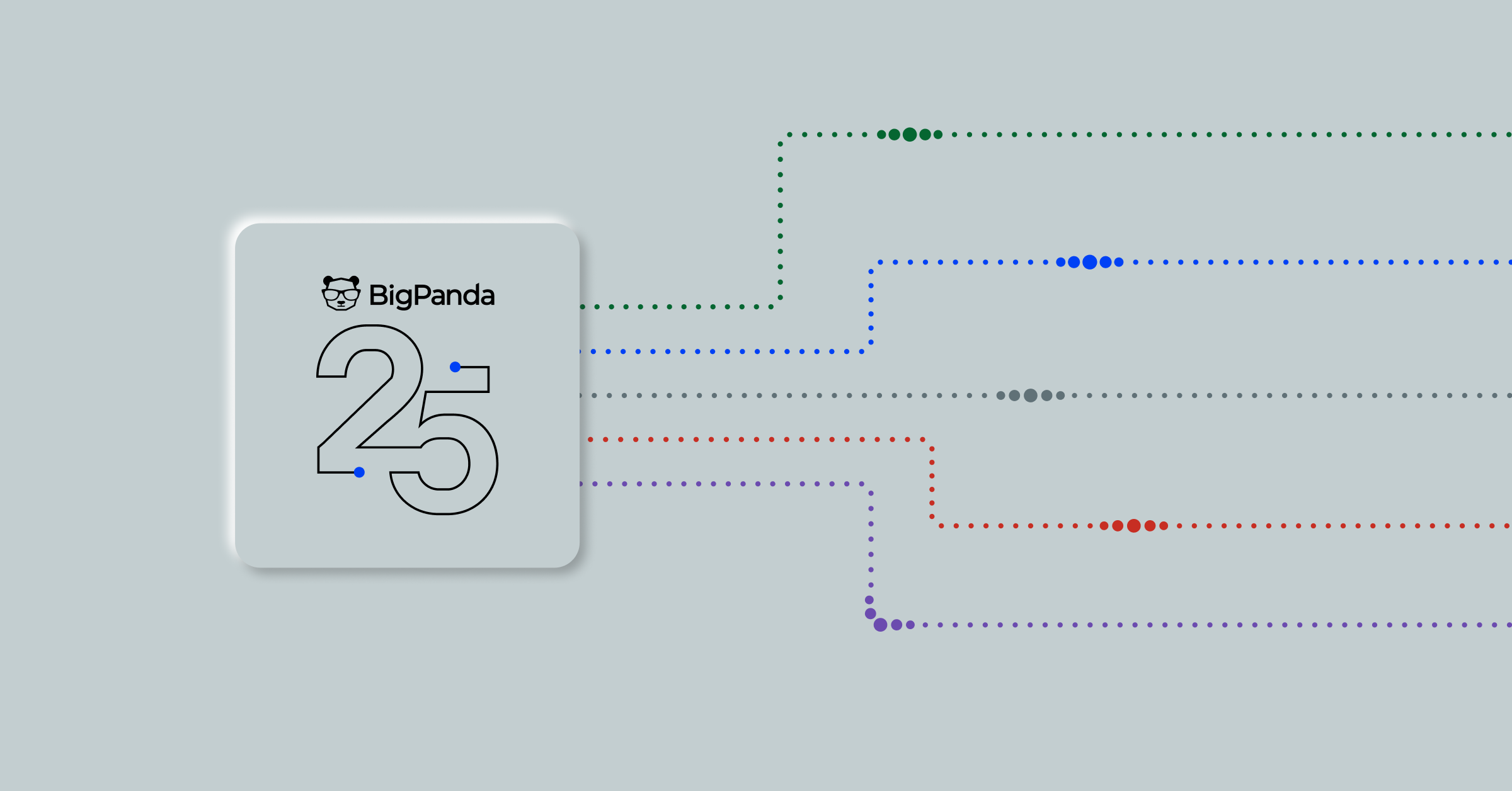1
Understanding IT discovery for ITSM and modern IT stacks
IT discovery is the process of systematically identifying all existing IT components within a tech stack. It involves discovering hardware and software, understanding their configurations, and mapping their interdependencies. Much like your annual doctor visit can proactively identify potential health issues, your IT discovery process can also flag problems and deliver insights to ensure improved operational well-being.
Even minor issues or changes can rapidly affect numerous components in hybrid IT stacks. Discovery enables you to stay ahead by accurately identifying and cataloging all IT assets so you can adapt to changes, maintain system integrity, and ensure seamless service delivery.
In this blog, we’ll delve into the what, why, and how of IT discovery. From the discovery process to the invaluable insights it provides, we’ll discuss its pivotal role in supporting IT Service Management (ITSM) practices in dynamic IT environments.
2
What is ‘discovery’ in IT?
IT discovery systematically identifies all existing IT components within a tech stack and shows their relationships.
It begins with conducting thorough a network sweep using specialized IT tools and then extends to locate all your assets across your entire tech stack, and includes cloud and on-prem hardware, software, services, applications, monitoring and observability tools, and components.
By employing IT discovery to map these systems, you can reveal relationships and dependencies while also observing, securing, and optimizing your components. Colidate your data across complex systems for full stack visibility and improve insights into application, infrastructure, and UX performance.
Armed with these insights, you can make proactive plans for data consolidation, migration, or modernization projects, ensuring a well-informed approach to managing and optimizing your IT infrastructure. However, IT discovery should not be confused with monitoring or service mapping.
3
What’s the difference between IT discovery and monitoring?
IT discovery focuses on identifying and cataloging all IT assets within a network, such as hardware, software, and network components, providing a comprehensive inventory of the IT environment.
It ensures you can discover asset relationships and be updated on any inventory changes. Think of IT discovery as mapping uncharted territory. The discovery process finds and identifies all your IT ecosystem’s devices, apps, and connections, often revealing hidden elements.
IT monitoring, on the other hand, goes beyond mapping out all assets and their relations and instead focuses on performance. Monitoring and observability tools continuously observe the performance and health of IT systems and infrastructure, often in real-time, to ensure they operate optimally and quickly identify and resolve issues.
If discovery maps out new landscapes, then monitoring is like standing guard over these known territories. Monitoring tools continuously observe the health and performance of your discovered assets, alerting you to issues before they cause trouble. In short, discovery finds what’s there while monitoring watches over it all.
4
How is service mapping different than IT discovery?
Colloquially, ‘service mapping‘ and ‘IT discovery’ are often used interchangeably. However, this obscures a key difference shown in the diagram below: IT discovery works from the bottom of the stack up, while service mapping works from the top down. While these tools can extend beyond the range depicted under ideal circumstances, in practice they rarely do.
Service mapping builds on both discovery and monitoring but goes a step further. It visually represents all these assets, details their interdependencies, and reveals how they collectively support specific business services, offering a more process-oriented view of the IT infrastructure.
Service mapping is like seeing the big picture and understanding how changes in one part can impact others and the overall user experience. So discovery finds the pieces, monitoring tracks their health, and service mapping shows how they fit together to support and deliver business services.
5
Why is IT discovery important for ITSM?
Managing a dynamic digital infrastructure requires organizations to support IT discovery. Here’s how IT discovery can help ITSM teams cultivate a robust and resilient digital infrastructure.
- Asset and configuration management: During IT asset audits, discovery identifies discrepancies in finance and IT records, revealing inactive or misconfigured devices impacts cost-effectiveness.
- In hybrid cloud environments, the importance of IT discovery becomes more pronounced. Gaining visibility into tech stacks can be inherently challenging, but meticulous IT discovery practices make it achievable. This ensures organizations are well-prepared to address challenges and have a resilient digital infrastructure proactively.
- Change management: For technical teams overseeing changes, insights from IT discovery data are instrumental in preventing unplanned incidents and understanding dependencies to ensure successful change implementation and maintained service availability.
- Release and deployment: In release planning, IT discovery provides visibility into dependencies, facilitating meticulous planning and validation before software installation. Post-deployment IT discovery continues to prove its worth during thorough post-verification checks.
- Incident management: When investigating incident causes, IT discovery provides invaluable information on service and component configuration, status, and dependencies. This knowledge empowers technical teams involved in incident resolution efforts, streamlining incident management processes.
- Information security: IT asset discovery is a crucial tool for mobile device management, aiding in identifying and managing BYOD scenarios. This mitigates data security risks linked to personal devices accessing sensitive business and customer information. Additionally, it plays a vital role in identifying access points during network enumeration for penetration testing.
- Service and disaster recovery: Data from IT discovery is critical after a significant disruption requiring a shift to a new IT environment. It plays a fundamental role in rebuilding IT services and streamlining the path to service recovery.
- Monitor customer digital experience: ITOps teams can better monitor customer digital experiences with IT discovery and insights into user interfaces. This comprehensive visibility into user interfaces ensures optimal performance and swift issue resolution.
- Baseline establishment: IT discovery aids in enabling the baseline of normal operations. Discovery draws from monitoring tools a continuous stream of data over time to establish a baseline of normal operations, this allows IT teams to identify deviations or new trends.
-
6
How does the IT discovery process work?
The IT discovery process systematically scans and collects data across networks, applications, hardware, software, and user interfaces (synthetic and real user monitoring), using specialized tools to identify and catalog IT assets and their configurations.
- Scan the entire stack: The IT discovery process starts with scanning the entire IT network. This is done using specialized software tools that automatically detect all devices and applications connected to the network. These include servers, workstations, routers, switches, and any other networked devices. After this, other tools are used to identify monitorable services, user interfaces, and hardware and software.
- Create an inventory: Once the scanning is complete, the IT discovery tools compile a detailed inventory of all identified IT assets. This inventory lists each asset, including its type (like a server or a router), location on the network, configuration settings, and other relevant details. This comprehensive inventory lays the foundation for a holistic understanding of the technological landscape.
- Map dependencies: Cracking the code of dependencies and relationships among diverse IT components is pivotal. The process involves mapping the dependencies between various IT components, such as which applications are hosted on which servers, and how data flows across the network.
- Auditing continuously: IT environments are dynamic, with changes occurring frequently. Therefore, IT discovery is not a one-time activity but an ongoing process. The discovery tools continuously scan the network, updating the inventory and dependency maps to reflect new devices, removed devices, or any changes in configurations.
- Analyze and make decisions: The final step in IT discovery involves analyzing the collected data. IT teams use this information to make informed decisions about managing the network, optimizing performance, planning for capacity upgrades, troubleshooting issues, or enhancing security measures.
In essence, IT discovery allows your ITOps team to systematically identify and catalog every component in an IT network and tech stack and understand how they all fit together. This process is crucial for effective management and optimization of IT resources.
7
The future of IT discovery requires AIOps
Traditional methods of IT discovery can’t keep up with the speed of change and innovation. AIOps rises to the challenge by enabling better discovery and tracking of dynamic tech stacks. Here’s how AIOps is a game-changer for IT discovery:
- Swift data processing: AIOps steps in with advanced automation and machine learning as the need for data in IT environments increases. Quickly processing and adding context to massive datasets from across your tech stack gives real-time insights into the status of IT components.
- Proactive issue identification: AIOps adds a predictive edge to IT operations. Drawing insights from historical patterns, it can anticipate potential issues across your stack before they occur, boosting the overall stability of IT services.
- Enhanced decision-making: With the ability to analyze and reveal relationships within IT ecosystems, AIOps transforms decision-making in IT discovery. Teams can use it to get a comprehensive view of their entire infrastructure, enabling more informed decisions about IT management.
- Scalability and adaptability: In the face of escalating complexity and scale within IT environments, AIOps assists with the scalability, veracity, and adaptability of IT discovery processes. Whether dealing with more devices or evolving technology, AIOps adjusts to meet the demands of modern IT landscapes.
- Enhanced observability: Efficient monitoring requires visibility into an extensive monitoring and observability tool stack. AIOps integrates with observability tools to streamline data sources and track tool changes in fast-paced IT landscapes, enabling DevOps and agile teams to minimize change risks effortlessly.
- Improved incident response: AIOps plays a crucial role in incident response, quickly analyzing data during critical incidents. This expedites the identification of root causes and solutions with greater efficiency, minimizing the impact of incidents on organizational operations.
8
How BigPanda improves observability and monitoring visibility with AIOps
Embracing IT discovery is key to staying ahead in a rapidly evolving tech world, ensuring your systems always align with business objectives and customer needs. BigPanda AIOps significantly enhances the IT discovery process by leveraging artificial intelligence and machine learning to enable the identification and mapping of complex dependencies within IT environments, particularly in dynamic, hybrid cloud infrastructures.
With BigPanda you gain:
- Centralized visibility across hybrid IT environments
- Cross-domain correlation and AI/ML integration
- Enhanced incident and outage management with Real-time Topology Mesh and Root Cause Changes
- Improved operational efficiency and service availability
Get a personalized demo and witness the power of AIOps with BigPanda. Now you can ‘discover’ how to provide your IT teams with accurate, real-time visibility into your network and systems for better decision-making and incident management.






